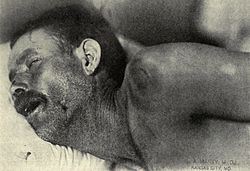
Neck stiffness, stiff neck and nuchal rigidity are terms often used interchangeably to describe the medical condition when one experiences discomfort or pain when trying to turn, move, or flex the neck. Possible causes include muscle strain or sprain, cervical spine disorder, meningitis, and subarachnoid hemorrhage. [1] [2] [3] [4] [5] [6]
Nuchal rigidity due to irritation of the lining of the brain and spinal cord is one of the main symptoms of meningitis.